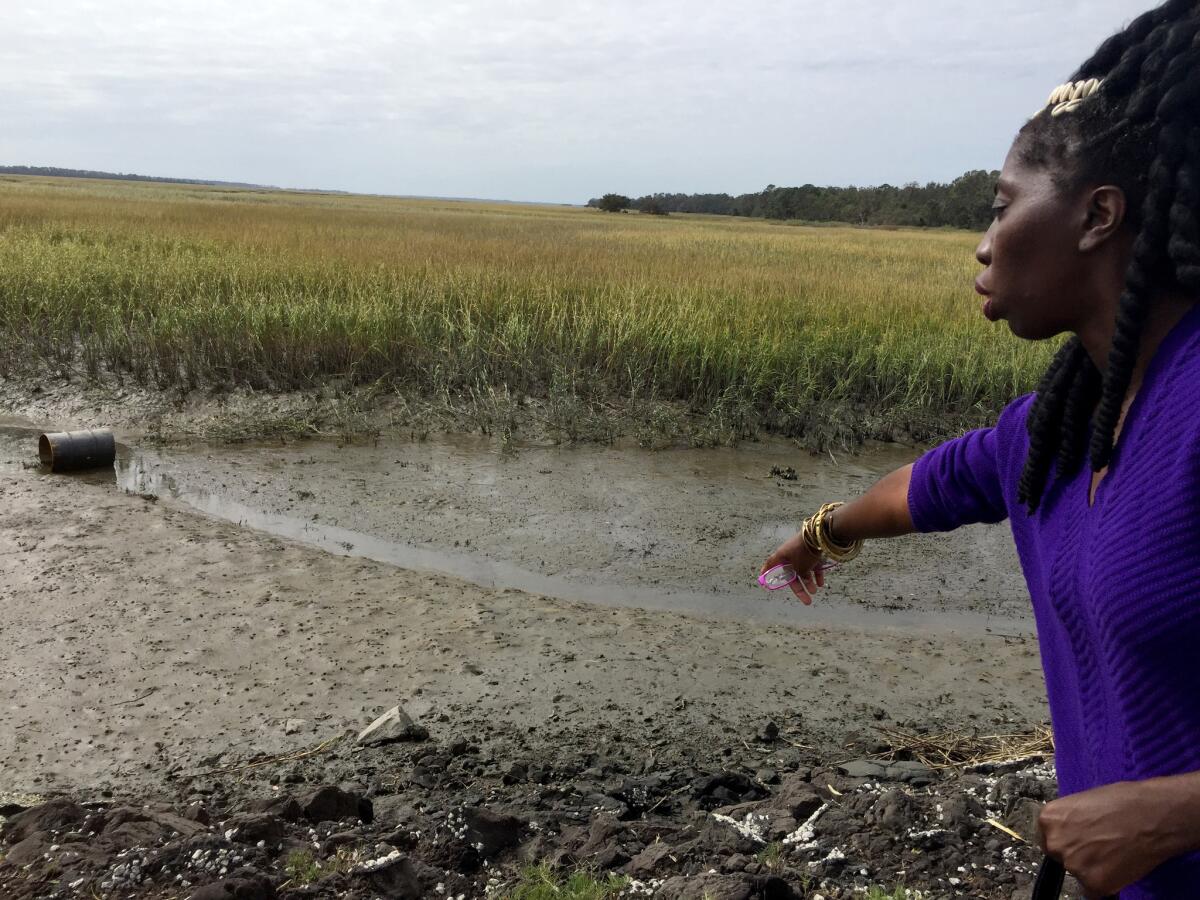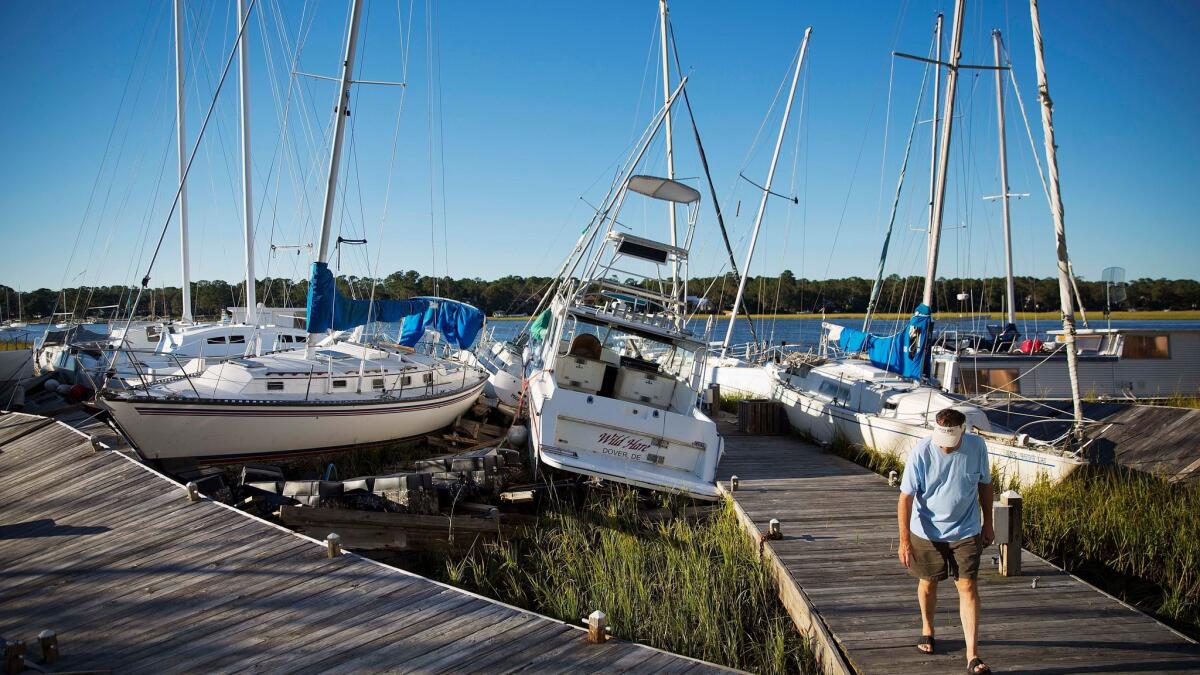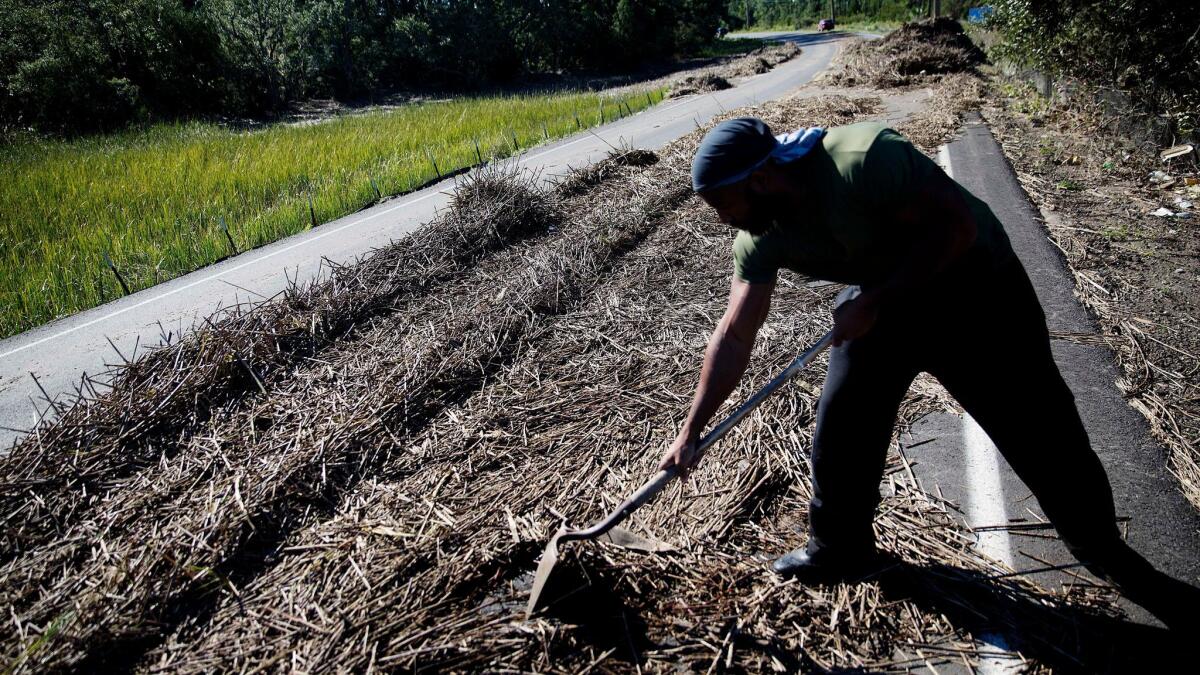The Gullah people have survived on the Carolina sea islands for centuries. Now development is taking a toll

Reporting from ST. HELENA ISLAND, S.C. — When the remnants of Hurricane Matthew threatened the coastal lowlands of South Carolina, 335,000 people fled for higher ground. Marquetta Goodwine stayed put.
Inside her purple-trimmed bungalow, built on land claimed by her ancestors from their slave masters, the chieftess of the Gullah people lit a lantern and listened. The storm roared ashore, overwhelmed the beaches, sluiced through cropland and ripped new docks from their marshy holdings.
The morning after, Goodwine drove as far as she could on the two-lane roads of this 63-square-mile island, stopping only when fallen trees or wires blocked her way.
Near the eastern tip, silt and sand had rushed out of the ocean, past the old tree line cleared by newcomers for a beachfront home, and settled on a watermelon field, where it weighed down the crops so only the tops of the fruit peeked out of the sediment.
“It looks like a field of severed heads, doesn’t it?” Goodwine said.
In 400 years of survival among the swampy marshes of the southeast coast of the United States, the Gullah-Geechee people knew better than to build on the shoreline, Goodwine said. History proved they should stop at the marshes, 100 yards inland.
But new arrivals sought the pristine beaches and rich hunting grounds of the South Carolina Sea Islands and began to build — seawalls to keep out the ocean, jetties to trap sand on their side of the shore, docks and piers for their boats.
But the seawalls caused beaches to vanish, jetties accelerated beach erosion and the docks cut off sunlight to the UV-dependent phytoplankton that support the ecosystem.
Then, the storms hit.
This year, what remained of Matthew slammed ashore with devastating timing in early October, arriving at the height of the harvest and the opening of oyster season, a crucial few weeks for the Gullah fishermen who support themselves on shellfish.
The storm washed sewage and golf-course runoff into the salt marshes of the coastal lowlands. The plume of chemicals cut off oxygen to the bacteria that decompose dead plants, which in turn feed the algae that serve as a food source for the snails, crabs and clams on the mud flats and hummocks that shelter the coast from the sea.
Without the crustaceans to support the root system of the island’s saltwater plants, erosion quickens and the coastline begins to sink. The toll on the marshlands eventually will bring worsening ocean surges to the place the Gullah-Geechee people have lived for four centuries, from their beginnings as a colony of slaves to freed men and women.
“Oysters and where one builds a home are critical to their cultural sense of self,” said Michael Benjamin, assistant professor of history at Armstrong State University in Savannah, Ga.
In the Carolinas, the people are referred to as the Gullah. In Georgia and northern Florida, they identify as either “saltwater Geechee” or, if they live near rivers, “freshwater Geechee.” A firm count of their total population on the Sea Islands and the interior coast is difficult, with some communities as small as 70 people living in remote hummocks and islands. As part of an application for protected status in 2005, the Gullah-Geechee estimated their total population at 200,000. They share a common patois filled with West African loanwords that is most akin to the language spoken in Jamaica.
As chieftess and head of state of the Gullah, Goodwine was able to make small tours of her island while the nearby tourist bastion of Hilton Head, S.C., was still inaccessible two days after the storm. She had little sympathy for the newcomers, whom the Gullah mock for their gated communities.
“You wanted the sun and fun,” Goodwine said. “You gated us out, now you can’t get in.”

It is an ugly coincidence that the flooding that now threatens the Gullah-Geechee once protected them. Slave owners fearful of tropical diseases made few trips to the islands, allowing the Gullah-Geechee to live in relative isolation.
In January 1865, after his “march to the sea” sent plantation owners scurrying south and west, Union Gen. William Tecumseh Sherman issued Special Field Order No. 15, which gave the freed black men the Sea Islands and abandoned rice plantations.
Through the oppressive years of Reconstruction and the Jim Crow South, the Ku Klux Klan never rode on St. Helena, a point of pride to the Gullah people here who were troubled only by taxes and the occasional meager harvest.
The first bridges to the mainland were built in 1950, and coastal development arrived with them when Charles Frasier began construction of the Sea Pines Plantation on Hilton Head Island in 1957. The newcomers broke with the Gullah’s codes and customs, building past the marsh line and gating themselves inside high walls. The Gullah’s cemetery islands were purchased and given new names such as River Town Country Club.
By 2000, poor rural black residents of the Sea Islands were far outnumbered by white, wealthy landowners. Taxes skyrocketed, forcing people from their inherited land. Some took minimum-wage jobs in the tony resorts.
Into this “unequal conversation” the Gullah have tried to muster some political power, said Bernie Mazyck, president of the South Carolina Assn. of Community Development Corporations.
“They have attempted to communicate with the developers through a public forum to express the impact of what that development is going to have on their way of life,” Mazyck said. “When you have a multimillion-dollar development coming into an area, it’s always going to be an unequal conversation.”
The Gullah have had their coastline declared a Cultural Heritage Corridor by the National Park Service. Goodwine has taken her case to the United Nations, where she met other ethnic groups that consider themselves indigenous or, at least, the longest-surviving arrivals. She found that Alaskan subsistence fishermen have rights her people can only dream of, particularly rules that exempt them from certain catch limits.

The developers on Hilton Head have begun to appeal to a new kind of tourist, said Josh Eagle, a maritime law professor at the University of South Carolina, “people who would rather see a maritime forest than a parking lot,” which has slowed building by the larger corporations on the Sea Islands.
Goodwine understands that the land lost to wind, water and newcomers won’t return, she says. But despite the best intentions of the federal government and international community, the Gullah still face intimate battles here on the islands.
South Carolina law makes no allowances for subsistence fishermen. Gullah oystermen have run afoul of catch limits instituted by the state, and racked up so many tickets that they cannot or will not pay that some of them have been jailed for unpaid fines.
“That was just the biggest sign that we’re not going to get help,” Goodwine said. “Making it criminal to do what we’ve done since we were brought here, auctioned here. Then maybe the oysters go away and the plants keep dying and the water keeps coming.
“Then you wonder why your foundation’s shaking. You wonder why your house broke down.”
Follow Nigel Duara on Twitter: @nigelduara
ALSO
Overweight, tattooed, stoned? The Pentagon may still want you
Californians aren’t the only ones voting on marijuana, gun sales and the death penalty
‘America’s toughest sheriff’ facing trouble at the ballot box and the courthouse
More to Read
Sign up for Essential California
The most important California stories and recommendations in your inbox every morning.
You may occasionally receive promotional content from the Los Angeles Times.











